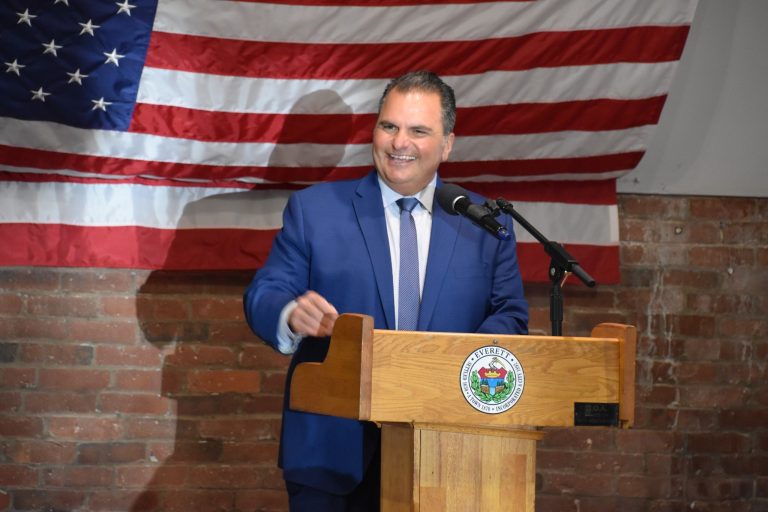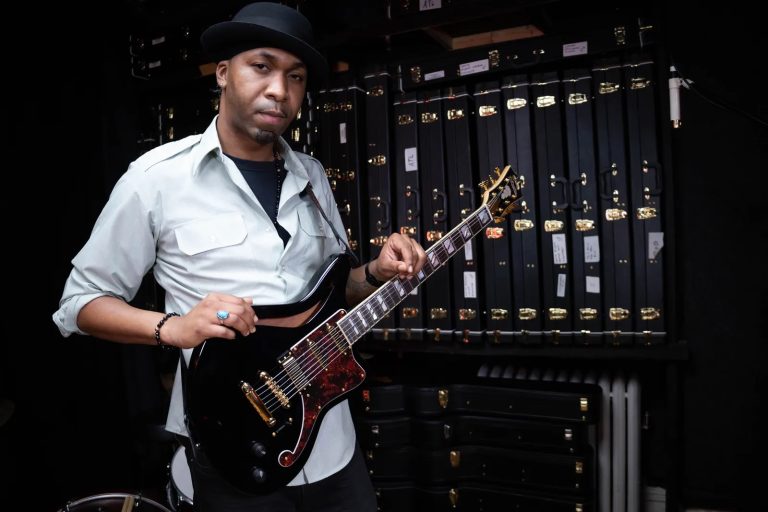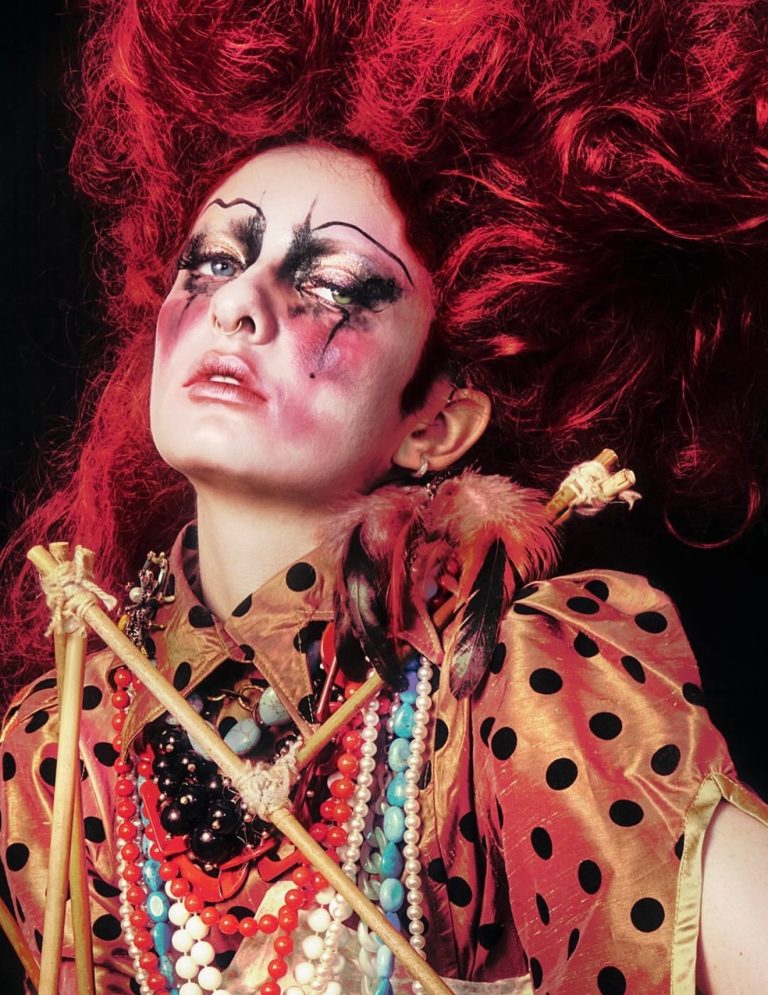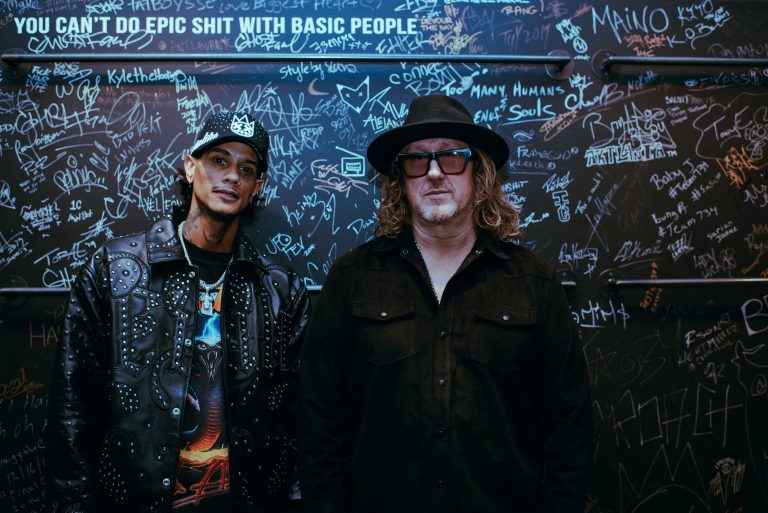He has been described as everything from ‘The Renaissance Man’ to the ‘Most Interesting Man in the World’ with his art and sense for adventure taking him all over the globe. Showing no signs of slowing down, Giovanni DeCunto shares how his new deal with Axiom Fine Art has set him up for his latest masterpiece.
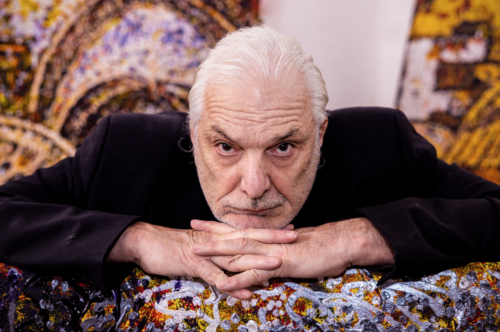
IT is a cold, dark, and rainy Thursday evening in mid-January. This time of year -and this type of evening- are when most Bostonians, still recuperating from the boisterous holiday and new year celebrations of a few weeks prior, retire to their residences early; hibernating until the weather -and city- turns back up.
Even though it is barely 6pm, the streets alongside Boston native Giovanni DeCunto’s Leather District studio are eerily quiet. Upon going up the stairs at 116 South Street though, and inside the internationally renowned artist’s mecca, you immediately feel a shift in vibration and energy as the warmth of his ART begins to fill you with life.
“This is my home,” DeCunto says of his workplace studio, where the backside of it actually does double as his condo. “Everything in here is a part of me.”
On this winter evening DeCunto is being photographed by a visual artist in his own right, Robert Hare, for the feature story you are now reading in BostonMan Magazine.
For decades DeCunto, whose art can be described as global expressionism, has been showcased all over the world. For starters, he has been found at The White House (yes, that White House), the Museum of Fine Arts here in Boston, the Smithsonian Museum in Washington D.C., the Fogg Art Museum at Harvard and The City Hall of Padua in Italy. And that barely begins to scratch the surface.
High-profile celebrities such as Lionel Richie, Shaquille O’Neal, Tom Cruise and George H.W. Bush to name a few have all tabbed DeCunto in adding custom pieces to their personal collections. Salman bin Abdulaziz Al Saud, the King of Saudi Arabia, even once commissioned DeCunto for a private painting displayed in his royal kingdom.
Heavily influenced by baroque and contemporary styles, DeCunto’s resume boasts arguably some of the greatest works produced during the modern era. His art has been credited with bridging the gap between old and new with “uniquely captivating results.”
As an artist, he’s accomplished more in his career than most could hope for in ten lifetimes.
But considering all of this, according to DeCunto himself, things are just now about to pick up for him professionally.
“This new deal is massive for me,” he explains without breaking pose as Hare adjusts the lens of his camera. “It is really going to make a difference in my career.”
The new deal DeCunto references is one he freshly signed to kick 2023 off with Axiom Fine Art, considered by many to be one of the most experienced -and best- art management groups globally. Led by its founder Russell Glotfelty, Axiom has amassed an impressive history of consistently placing prestigious artwork in luxe environments around the world.
“I’ve come a long way,” DeCunto reflects, slight grin breaking across his face. “It took a lot to get here.”
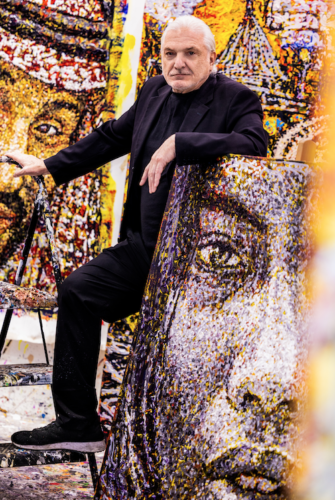
A KID FROM LAWRENCE
BORN John Pasquale DeCunto on March 13, 1949 twenty-five miles north of Boston in the textile city of Lawrence, Giovanni (he later on changed his name) was the oldest of three siblings alongside twin sisters. The family grew up modestly in what he describes as “an artist’s household.”
His father, Giovanni, was an Italian dancer and painter, who while living in Los Angeles was said to be a favorite dance partner of Rita Hayworth, Lana Turner and other Hollywood starlets during the 40’s. To this end, it was indeed on a showbiz dance floor that the elder Giovanni met his future wife. The news of a pregnancy in 1948 prompted the couple to pack their bags, dancing shoes and all, and trek east where they would raise their family away from the bright lights of Hollywood.
By the age of five DeCunto knew he wanted to be a painter.
“It was a calling for me,” he says. “I used to go down into the basement (at school) where they had all of these paintings and pictures. The first time I saw Leonardo (DaVinci) it moved me.”
He continues: “I became obsessed. I was so competitive by second grade I was already going up against high school kids in local shows and beating them.”
This obsession, he says, had him thinking about art all hours of the day, plotting what course he thought he would need to partake in becoming most successful at his craft.
“I stayed back (in school) four times because I was neglecting my other classes,” DeCunto says. “My parents were immigrants, still getting acclimated here, so they really didn’t know to tell me better.”
There were many challenges and adjustments for Italian immigrants coming to America in the first half of the 20th century. Those pressures, perhaps along with the fast lifestyle Giovanni Sr lived in Hollywood, could have contributed to developments of Schizophrenia that ultimately led to the elder DeCunto being admitted to Danvers State Hospital while Giovanni Jr and his sisters were still young. He would live out the remaining thirty-five years of his life there under medical supervision.
Amongst this turbulence, by age fifteen, Giovanni found himself living off the streets in abandoned buildings and automobiles.
“It was rough,” DeCunto says. “There was a time there I didn’t know where I was going to be next.”
Yet no matter how dire things sometimes got, DeCunto always stayed focus on his art. He knew he wanted to go to college and in order to do so would need to catch up on his general studies. He buckled down and caught up with all of his necessary schoolwork to graduate.
Universities throughout the country, meanwhile, were taking notice of the emerging young artist from Boston, and scholarship offers began to come in. There was only one problem though.
“Without a permanent address I had no way of implementing them,” DeCunto says of the offers to travel for school.
He ended up choosing the now defunct Vesper George School of Art on St. Bodolph Street in Boston, hitchhiking his way to and from class throughout his first year.
By his second year, DeCunto, still living primarily off the streets, discovered a way to simultaneously improve his commute and spend more time focused on art.
“I found it easier if I just dated and lived with women close to campus,” he says laughing.
Despite continued excellence in his studies, DeCunto, still without a permanent address, was failing to fill out some of the paperwork required to continue his education. Eventually the university caught on.
“So I ended up flunking out,” he says with a shrug.
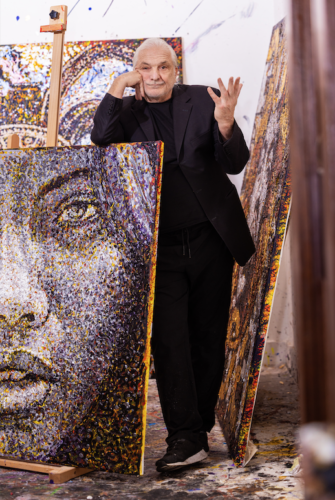
EINO & VIVIAN KEERD
RATHER than figuring out a way to re-enroll in college, Giovanni felt a better course was to concentrate on selling more of his art. There was a growing buzz surrounding him and with that came a demand to produce more pieces.
DeCunto secured a seventh-floor art studio in a building right outside the Berklee College of Music. There, he was able to also work as an elevator operator helping him earn some much-needed extra cash. For the first time in years, there was a semblance of stability beginning to form in Giovanni’s life.
It is during this time DeCunto met Eino and Vivian Keerd, a life-changing moment for him, as the couple would go on to provide structure, guidance, and mentorship he badly longed for.
“Eino was no nonsene,” DeCunto says. “He was exactly what I needed at that time in my life.”
Born in Estonia, Eino Keerd escaped from behind the Iron Curtain with his family as a youngster. The legend of his physical prowess in Boston are only matched by the toughness of his mental fortitude.
As a Track & Field athlete competing in strength events at Boston University in the late 50’s, Keerd was twice the NCAA national shot-put champion, the national 35-lb weight champion, and runner-up (to teammate John Lawlor) as the national hammer throw champion. He helped bring international recognition to BU in Track & Field, and the Terriers narrowly missed winning the 1959 NCAA national team title.
In the early-70’s, when DeCunto met him, Keerd was establishing himself as a not-to-be-messed-with land developer throughout Boston. He had influence in the city.
Eino and his wife Vivian were also lovers of art.
Before long, the Keerds had commissioned Giovanni for roughly 100 custom pieces and his art was surfacing in the upper echelon museums around Boston as well as at the Smithsonian in Washington DC.
Says DeCunto: “All of a sudden I was in four museums and I said ‘oh crap, I better go back to school and finish my studies.’”
One call from Eino to his alma mater BU had Giovanni’s work in front of David Aronson, who had formed the Fine Art School there. Just like that DeCunto was back in college on scholarship.
“Eino always told me: ‘Every time you go to the next level, you are going to go back to where you started emotionally’ and it’s true,” DeCunto fondly recalls of his mentor.
As DeCunto was reengaging with his academics, Keerd was closing a deal on a new 70-room luxury hotel in Boston. Giovanni now had a new load of university work to complete, and a beautiful building to display it, in need of his art. Things were beginning to fall into place.
While at BU, DeCunto studied directly under and with artists that helped influence The German Expressionist style.
Originally from Lithuania, Aronson was inspired by and exhibited regularly in Berlin and Copenhagen. As a result, he was able to frequently study with Horst Woldemar Janson, a Russian Empire-born German-American professor whose ‘History of Art’ (first published in 1962) has sold over four million copies in fifteen different languages.
These influences played a key cog in Aronson’s contributions to Boston Expressionism, and guided DeCunto to realizations that he identified as an expressionist as well.
“It was like receiving inside information,” DeCunto says of the apprenticeship and educational opportunities available through the Janson/Aronson lineage. “I took full advantage of it. I would just stay in class, even the ones I was not registered for. They used to have to kick me out, and I got a little bit of a reputation over it, but I didn’t care. I was soaking up everything I could from these guys. I was obsessed.”
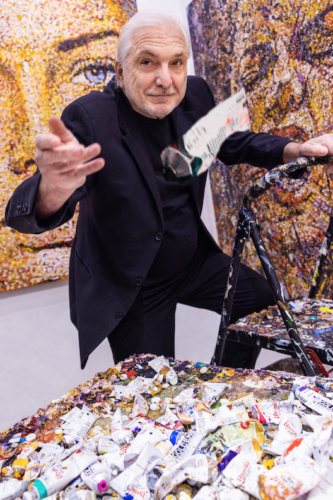
LUNCH AT THE WHITE HOUSE
WHILE DeCunto was raising eyebrows throughout New England with his artwork, 450 miles south of Boston down I-95, Rex Scouten was proving to be an invaluable asset for the Richard Nixon Administration as its Chief White House Usher, a position he would hold from 1969-86.
A veteran of Cold War military intelligence, Scouten was a member of the Secret Service for eleven years; serving on Nixon’s personal Vice President detail from 1953-57. In 1960, the Kennedy administration moved him over to assistant White House Usher, before Nixon promoted him to Chief Usher once ascending the Presidency at the end of the decade.
Scouten, a world history buff, customarily toured the rich artifacts and museums of the nation’s capital. An art scholar, he was often in the Smithsonian, where the work of a young artist from Boston regularly caught his attention.
He decided it was time to put in a call to Giovanni DeCunto.
“I thought it was a hoax,” DeCunto says of receiving the initial call claiming to be The White House. “I thought my buddies were playing a joke on me so I told Mr. Scouten to eff off and I hung up the phone on him.”
Scouten called back, however, and before Giovanni could hang up a second time had him scribble down a number, which had a ‘202’ area code to call back.
“Turns out it was really him,” Giovanni muses.
Never one to pass up an opportunity, DeCunto improvised on the fly and told Scouten he was planning on going to Washington DC for his spring break in a few weeks and they should connect to talk about his painting.
“Great,” Scouten told him. “We can grab lunch.”
“Where do you want to meet?” Giovanni asked.
“The White House.” Scouten answered
So on March 13th that year, DeCunto’s birthday, he and Rex Scouten, Chief Usher of The White House met for lunch.
“I nearly fell out of my chair,” DeCunto says. “I thought we were just going to grab a burger somewhere.”
What few people knew at the time, Scouten was actually being groomed to replace Clement Conger as White House Curator (a position he eventually held from 1986-1997 under the Reagan, Bush, and Clinton administrations) and had his eye on DeCunto to potentially paint the Presidents.
Also unbeknownst at the time, the Director of the Central Intelligence Agency, a Milton, MA native and future Vice President and President of the United States, George Herbert Walker Bush, had seen DeCunto’s painting at the Smithsonian as well and was impressed with the piece.
In fact, shortly after this visit, Scouten put in a call to Bush, and before you knew it his wife Barbara was reaching out to commission DeCunto for the now famous painting that hangs in the George Bush Presidential Library of her literacy campaign.
That birthday lunch proved to be one of the best DeCunto has had in his 70+ years on earth.
“Rex Scouten became my new mentor that day. Once I found my seating and got comfortable in (The White House) I really held my ground with him,” DeCunto remembers of their initial meeting. “We hit it off. He invited me into a two-year program for Very Special Arts called ‘An American Collection.’ I was only one of six selected. I got to sell my paintings all over the world.”
The tour secured placement of DeCunto’s work into permanent collections both internationally and homeland. Among them: The Reusch Collection in Zurich, Switzerland, The Monarch Club, and the University of Kentucky. It also paved the way for an exhibition at the EUNO Royal Museum in Japan, commensurate with a retrospective of Jackson Pollock and Robert Mapplethorpe.
“He really knew art,” DeCunto emphasizes of Scouten. “And one call or letter from him got you in anywhere in the world.”

UNA BORSA DI STUDIO ITALIANA
FOLLOWING his ‘spring break’ in Washington DC and visit with Rex Scouten, DeCunto finished up his university work that spring under the tutelage of Bronson and the BU Fine Art School.
There was an opening for the prestigious ‘Fellowship for Renaissance Study’ at the University of Padua in Italy that had caught Giovanni’s eye, and one quick call to Scouten ensured he would be included in the program.
“A big part of my obsession has always been about having the best education in art,” DeCunto reflects. “Now all of a sudden at Padua, it was all right there in front of me.”
Dating back to when he was five years old, and saw his first Leonard Da Vinci painting, DeCunto says he always felt a gravitational pull towards Italian Renaissance.
“DaVinci always said that in order to move forward you must first learn everything that came before you,” DeCunto explains. “And for me to be able to study the original sculptures and interpretations of the Italians during the Renaissance once they received the mathematics and formulas from the Greeks was a pivotal moment in my education.”
He adds: “I want to emulate many of the masters in my art. This is a key part of my education. Even if I am just using something small from a craft, it is something that had pushed a style or era forward and something I can build on with my own art.”
Studying at Padua, the pinnacle of Classic masters, DeCunto was able to further develop his vision to redefine classical genre by merging impressionism, expressionism, and other significant movements into his own robust mode of expression.

SHIP IT BACK TO BOSTON
“I ALWAYS had a feeling something big was going to happen again with art in Boston,” DeCunto says.
With the completion of his fellowship in Italy, Giovanni briefly entertained offers from literally every corner of the globe on where next to set up shop. Deep down, he knew he wanted to be back in Boston though.
“Back in the 40’s and 50’s the art and expression in Boston was some of the best in the wrold,” he explains. “There was a little bit of a Boston boom within the arts during that time. I didn’t want to not be here to experience that when it was to happen again.”
Still, DeCunto was feeling a little fatigued and knew he needed to at least momentarily take a small step back.
“It’s not that I took a hiatus,” he expresses about this time. “I just made a conscious decision to lay a little bit lower than I had been for a while.”
DeCunto moved to the North End, Boston’s Little Italy, where he easily picked up commissioned ristorantes for work regularly. He maintained a visible presence in museums, and of course, stayed in touch with mentor Rex Scouten, who now had officially ascended to Curator of The White House.
The Raegan years were over, and President George H.W Bush was beginning to campaign for his own re-election, which would culminate at the 1992 GOP National Convention in Houston.
While reviewing forthcoming décor details with Scouten, Bush had a question he was hoping his White House Curator would have an answer for:
“Whatever happened to that talented artist from Boston that painted Barbara’s literacy campaign piece?” the 41st Commander-in-Chief of America asked. “Is he available?”
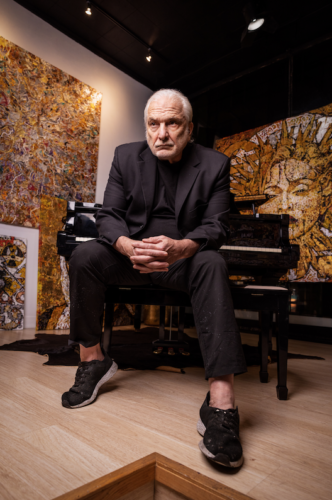
SPIRIT OF AMERICA
AS DeCunto walked around the inner perimeter of the Houston Astrodome with President Bush and Scouten discussing themes that would make the statement the GOP sought after for the convention, one thing became apparent very quickly.
“They wanted it to be colossal,” DeCunto says.
Once dubbed the ‘Eighth Wonder of the World’ the Astrodome, when built in 1966, was designed to be the model for future indoor complexes.
But that was nearly thirty years ago, and by the early 90’s the once mighty Astrodome had fallen on difficult times now being considered outdated and obsolete by an America that was racing towards a world of internet, cellular devices, and cooler technologies.
This was an overall theme the Democratic party were hoping to capitalize on with Bill Clinton’s campaign as well; presenting their candidate as thirty-two years younger and ‘more hip’ than the sitting President; therefore, they aimed to convey, a better choice for a faster moving America.
Although they were not outwardly saying it, the GOP knew this was something they needed to address. And soon.
“People can say a lot of different things about me,” DeCunto states. “But one thing they can never call me is boring. I’ve always been able to create some level of excitement.”
The mission was clear. DeCunto needed to produce a painting that had size, power and stature; and he needed to present it with a vibrance showing modish of the 1990’s. George H.W Bush needed to be captured as the modern day ‘Spirit of America.’
On August 17, 1992 when the GOP National Convention commenced, at its centerpiece stood a breathtaking 18-foot masterpiece portrait that instantly became the buzz of the convention. It was a stunning work of art that will stand tall with the tests of time.
Bill Clinton would eventually go on to edge out President Bush to become the 42nd President of the United States, but in late summer 1992 one thing became abundantly clear: George H.W Bush was still pretty freaking cool.
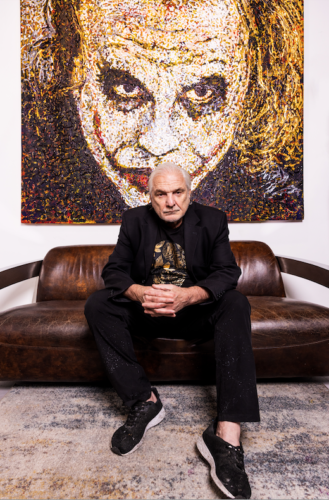
LIKE FORREST GUMP
THE list goes on for DeCunto. Even he can’t always keep track of it all.
“I had an attorney tell me once that I was kind of like Forrest Gump in that regard,” he says. “I keep bumping into stuff.”
The comparison isn’t far-fetched. DeCunto has created directly with: Tiger Woods, Tom Cruise, Katie Holmes, David Ortiz, Tony Bennett, James Gandolfini, Lionel Ritchie, Shaquille O’Neal, Roger Clemens, Frank Thomas, Adam Vinatieri, and recently Jayson Tatum and Marcus Smart.
In 2019, he repainted the thirteen stolen pieces of art from the Isabella Stewart Gardner Museum as part of one of his latest collections.
“I studied all of these paintings thoroughly,” DeCunto says of the tribute. “The thefts of these great works hit the art community like thirteen daggers to the heart.”
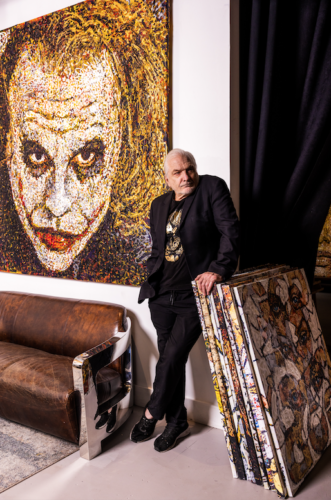
AXIOM – THE NEW DEAL
WITH all that has led to this point, it is hard to imagine there is much more left out there for DeCunto to do.
“There’s so much more,” he quickly corrects. “This is why I am ecstatic about the new deal with Axiom.”
The deal -which will see Axiom Fine Art further penetrate DeCunto’s paintings around the globe; specifically high concentrations with luxe galleries in New York, Miami, Los Angeles, Toronto, and Nice, France- is a partnership DeCunto says he has worked his entire life towards.
“Russell (Glotfelty) and Marco (Hussen) are like a dynamic duo,” Giovanni says of the founder and partner of Axiom. “They really are a dream to work with. The intelligence and talent they have in this space is inspiring. This will be a solid note to the artworld.”
The sentiment towards DeCunto is mutual with Axiom:
“We are excited to have Giovanni join the family,” Glotfelty says. “His work is exceptional, and we are excited to assist in bringing his work to the forefront of the marketplace. Our goal is to always have artists creating when we strategize how to let the world see their vision.”
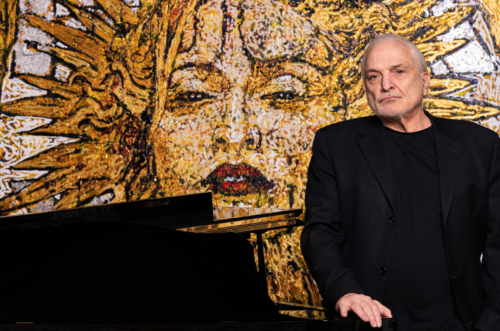
THE RENAISSANCE MAN
BACK in Giovanni’s South Street studio, the energy is so bright during our photoshoot it’s easy to forget there is a monsoon happening outside.
Jay Z’s ‘Picasso Baby’ is appropriately vibing throughout DeCunto’s studio sound system and Robert Hare is crushing the shoot.
“This is my favorite part,” DeCunto announces pointing upward, head nodding, as Jay Z picks up his second verse:
“It ain’t hard to tell/ I’m the new Jean Michel/ Surrounded by Warhols/ My whole team ball/ Twin Bugattis outside the Art Basel/ I just wanna live life colossal/ Leonardo Da Vinci flows/ Riccardo Tisci Givenchy clothes/ See me throning at the Met/ Vogueing on these…/ Champagne on my breath, yes/ House like the Louvre or the Tate Modern/ Because I be going ape at the auction/ Oh what a feeling/ Aw fuck it I want a trillion/ Sleeping every night next to Mona Lisa/ The modern day version/ With better features/ Yellow Basquiat in my kitchen corner/ Go ahead lean on that shit Blue/ You own it..”
You can feel the influences of all the great artists and eras DeCunto incorporates into his work. Something forever embedded in him and his work through his obsession, his calling he first felt with DaVinci and the Renaissance.
I ask him, if he had to, how he would sum up an artist -a man- as complex as himself:
“It all connects,” he tells me. “My technique integrates impressionists, pop, classical, photo realism and abstract expressionism all together. I threw away all of my tools and used action painting as my vehicle. You have to understand the four points of impressionism to create and define what we are supposed to do today. With the duality of classism and the fickleness of pop our journey has created culture. We just can’t see it. Open your eyes and try to learn how to see. It will blow your mind.”
With the Axiom deal ready to take off, a lot more eyes are about be opened to the work of Boston’s Renaissance Man, Giovanni DeCunto.
Perhaps it all does connect, even our senses. Because I also now hear Jay Z’s ‘Picasso Baby’ a little differently:
“Oh what a feeling/ DeCunto Baby, De Cunto baby/ De De DeCunto Baby..”
Giovanni’s right. It really does blow your mind.
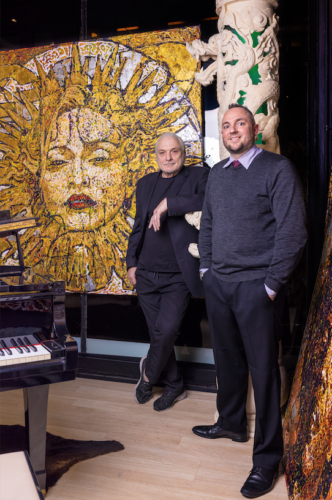
All images by Robert Hare of Robert Hare Photography



